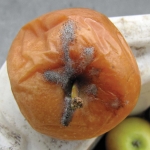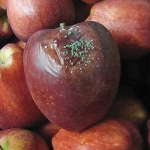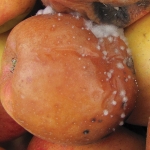Those rotten apples you find in bins of fruit as you pull them from storage for packing and sale had their genesis several months ago, when you picked those apples and put them into storage.
While there are several kinds of rots you might see in those apples, you can go a long way toward preventing them with a well-timed preharvest fungicide spray.
Save at least one of your apple fungicide sprays of Merivon or Pristine for application just before harvest, says Dr. Kari Peter, tree fruit pathologist at Pennsylvania State University’s Fruit Research and Extension Center at Biglerville, Pennsylvania. Either can protect your apples from postharvest rots that show up in apples during storage.
Both Merivon and Pristine are BASF products and mixtures of two fungicides, each of them containing pyraclostrobin. Merivon also contains xemium, while Pristine contains boscalid as the second ingredient.
“These chemicals are not cheap,” Peter said. “But they live up to their reputation of protecting apples in storage. They work.”
Since fungicides should be rotated for good resistance management, and their label limits number of uses of both Pristine and Merivon each season, you should reserve one of them for the last spray before harvest, she said. Either fungicide can be applied four times during the season for control of a range of diseases, and there is no preharvest interval, so they can be applied right at picking time.
While the rots are different, they fall into two categories: Those that enter apple tissue only through bruises, punctures, and other wounds, and those capable of invading undamaged apples.
Blue mold and gray mold occur exclusively in storage, Peter said. They are not problems on fruit in the orchard. Their spores are ubiquitous, but they invade only wounded tissue, and wounding most frequently occurs during harvest.
While cold storage will slow down the rotting process, some strains of penicillium mold are quite aggressive, and rot will show up after only a few weeks in cold storage.
“Blue mold caused by Penicillium expansum is the most important postharvest disease on pome fruit occurring during storage,” Peter said. “Gray mold caused by Botrytis cinerea is the second most important postharvest disease on pome fruit, and is especially so on pears. Blue and gray molds require a wound to cause disease and are typically not a problem during preharvest.”
Mucor rot, also associated with fruit injuries, occurs on both apples and pears, and can cause significant fruit losses. “What’s really bad about mucor rot is it grows like a weed once infection starts and there are no registered fungicides to control it,” Peter said.
Mucor rot can be a problem when chlorine levels in dump tank and flume water are inadequate. Soil debris on bins is a major source of inoculum that spreads during drenching and packing. In its early development, mucor rot can be mistaken for blue mold.
Additional problematic diseases popping up in storage include white rot, black rot, and bitter rot. “Unlike blue and gray molds, these diseases can be a preharvest issue, appearing on fruit in the orchard,” Peter said. Fungal spores that land on fruit while still on the tree can cause problems later. “Asymptomatic fruit appear clean when put into storage; however, it’s a different story when they come out. All apple cultivars are susceptible to these diseases.”
Black, white, and bitter rots are greater problems in the East, where the weather is hot and humid, than they are in the arid West.
Besides a preharvest spray, some other general management techniques will help reduce postharvest fruit rots:
—Bruised or wounded fruit are susceptible to blue mold and
gray mold. While harvesting, handle fruit carefully when picking and transferring fruit from bag to bin to avoid bruising or wounding.
—The more mature a fruit, the more susceptible it is to storage diseases. Harvest fruit at proper maturity.
—Inoculum sources for pathogens causing disease in storage (if not already hitching a ride on the fruit) come from plant and soil debris. Use clean bins and minimize the amount of soil and plant debris brought in on bins.
—Keep fruit cool after harvest. Warm temperatures encourage pathogens to grow.
—If delivering to a packing house, minimize time between harvest and delivery of fruit.
To minimize the threat of rots next season, there are things you can do before, or early in, the growing season.
—Practice orchard sanitation. Prune out cankers, dead branches, and mummies that serve as inoculum sources. Mucor rot is a soilborne pathogen that survives in orchard soil and enters storages in soil adhering to bins. Fallen fruit can become infested with mucor rot inoculum and serves to contaminate bins in the orchard.
—Prune for increased airflow to promote faster drying and better spray penetration. Ensure good spray coverage.
—Improve fruit quality through nutrient programs, such as applying calcium sprays. Fruit with adequate calcium are less vulnerable to rots.
—Control insects that may act as vectors of diseases. •




Useful info. Lucky me I discovered your website by
chance, and I am stunned why this accident did not
happened earlier! I bookmarked it.